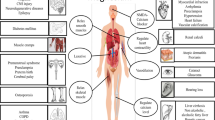Summary
The effect of carbidopa on the pharmacokinetics and metabolism of levodopa (l-dopa) in blood plasma and skeletal muscle extracellular fluid (ECF) has been studied by repeated measurements in one beagle dog.
The administration of a single dose of l-dopa (25 mg/kg i.v) without carbidopa pretreatment (controls) resulted in an increase in the concentrations of l-dopa and 3-O-methyldopa (3-OMD) in blood plasma and skeletal muscle ECF dialysates. This effect was clearly potentiated for l-dopa in blood plasma (186% increase in AUC) and 3-OMD in skeletal muscle dialysates (108% increase in AUC) after pretreatment with carbidopa (100 mg/day). In addition, carbidopa prolonged the halflife of the elimination of l-dopa in blood plasma by 48% and in skeletal muscle ECF by 66% but did not influence its blood plasma distribution half-life (t1/2 α = 0.17 h). The elimination half-life of l-dopa in the controls was higher in muscle (t1/2 β = 1.76 h) than in blood plasma (t1/2 β = 0.50 h). Carbidopa pretreatment resulted in a relatively small increase (29%) in the l-dopa content of skeletal muscle ECF as indicated by the AUC.
The accumulation of 3-OMD in muscle dialysates, in contrast to that in plasma, was significantly enhanced after the administration of l-dopa following treatment with carbidopa. In the control experiments, dopamine (DA) was detectable only in the dialysates from muscle ECF 3,4-Dihydroxyphenylacetic acid (DOPAC) concentrations in dialysates from blood plasma and muscle showed similar changes in their pharmacokinetic profiles following carbidopa treatment suggesting that their concentrations reflected the formation of these metabolites at other peripheral organs.
Our data support the hypothesis that carbidopa, at least in this experimental setting, exerts a l-dopa sparing effect in skeletal muscle ECF and therefore might play a role in maintaining blood plasma levels of this amino acid.
Similar content being viewed by others
References
Axelrod J, Tomchick R (1958) Enzymatic O-methylation of epinephrine and other catechols. J Biol Chem 233:702–705
Coutinho CB, Spiegel HE, Kaplan SA et al (1971) Kinetics of absorption and excretion of levodopa in dogs. J Pharm Sci 60:1014–1019
Daniel PM, Pratt OE, Spargo E (1977) The metabolic homeostatic role of muscle and its function as a store of protein. Lancet II:446–448
Deleu D, Ebinger G, Michotte Y (1991a) A clinical and pharmacokinetic comparison of oral and duodenal delivery of levodopa/carbidopa in patients with Parkinson's disease with fluctuating responses to levodopa. Eur J Clin Pharmacol 41:453–458
Deleu D, Sarre S, Herregodts P, Ebinger G, Michotte Y (1991b) Continuous intravenous monitoring of levodopa and 3-O-methyldopa by microdialysis and high performance liquid chromatography with electrochemical detection. J Pharm Biomed Anal 9:159–165
Deleu D, Sarre S, Ebinger G, Michotte Y (1991c) In vivo pharmacokinetics of levodopa and 3-O-methyldopa in muscle. A microdialysis study. Naunyn Schmiedebergs Arch Pharmacol 344: 514–519
Deleu D, Sarre S, Ebinger G, Michotte Y (1993) Simultaneous monitoring of levodopa, dopamine and their metabolites in skeletal muscle and subcutaneous tissue in different pharmacological conditions using microdialysis. J Pharm Biomed Anal 11:577–585
Fahn S (1974) On-off phenomenon with levodopa therapy in parkinsonism. Clinical and pharmacologic correlations and the effect of intramuscular pyridoxine. Neurology 24:431–441
Guldberg HC, Marsden CA (1975) Catechol-O-methyltransferase: pharmacological aspects and physiological role. Pharmacol Rev 27:135–206
Hardie RJ, Lees AJ, Stern GM (1986) Pharmacokinetics of levodopa and motor fluctuations. Adv Neurol 45:487–492
Levin JA, Wilson SE (1977) The effect of monoamine oxidase and catechol-O-methyltransferase inhibitors on the accumulation and metabolism of [l 3H]norepinephrine by the adventitia and media of rabbit aorta. J Pharmacol Exp Ther 203:598–609
Nutt JG, Woodward WR, Anderson JL (1985) The effect of carbidopa on the pharmacokinetics of intravenously administered levodopa: the mechanism of action in the treatment of Parkinsonism. Ann Neurol 18:537–543
Obeso JA, Grandas F, Vaamonde et al (1989) Motor complications associated with chronic levodopa therapy in Parkinson's disease. Neurology 39 [Suppl 2]:11–19
Ordonez LA, Romero JA, Wurtman RJ (1972) Tissue distribution of l-dopa: evidence for a reservoir in skeletal muscle. Fed Proc 31:589
Ordonez LA, Arbrus M, Boyson S, Goodman MN, Ruderman NB, Wurtman RJ (1974) Skeletal muscle: reservoir for exogenous levodopa. J Pharmacol Exp Ther 190:187–191
Pardridge WM (1977) Kinetics of competitive inhibition of neutral amino acid transport across the blood-brain barrier. J Neurochem 28:103–108
Romero JA, Lytle LD, Ordonez LA, Wurtman RJ (1973) Effects of l-dopa administration on the concentration of dopa, dopamine and norepinephrine in various rat tissues. J Pharmacol Exp Ther 184:67
Rose S, Jenner P, Marsden CD (1988) The effect of carbidopa on plasma and muscle levels of l-dopa, dopamine, and their metabolites following l-dopa administration to rats. Mov Disord 3:117–125
Sasahara K, Nitanai T, Habara T, Morioka T, Nakajima E (1980) Dosage form design for improvement of bioavailability of levodopa. II. Bioavailability of marketed levodopa preparations in dogs and parkinsonian patients. J Pharm Sci 69:261–265
Spargo E, Pratt OE, Daniel PM (1979) Metabolic functions of skeletal muscles of man, mammals, birds and fishes: a review. J R Soc Med 32:921–925
Author information
Authors and Affiliations
Additional information
Correspondence to: D. Deleu at the above address
Rights and permissions
About this article
Cite this article
Deleu, D., Sarre, S., Ebinger, G. et al. The effect of carbidopa on the pharmacokinetics and metabolism of intravenously administered levodopa in blood plasma and skeletal muscle. Naunyn-Schmiedeberg's Arch Pharmacol 348, 576–581 (1993). https://doi.org/10.1007/BF00167232
Received:
Accepted:
Issue Date:
DOI: https://doi.org/10.1007/BF00167232




